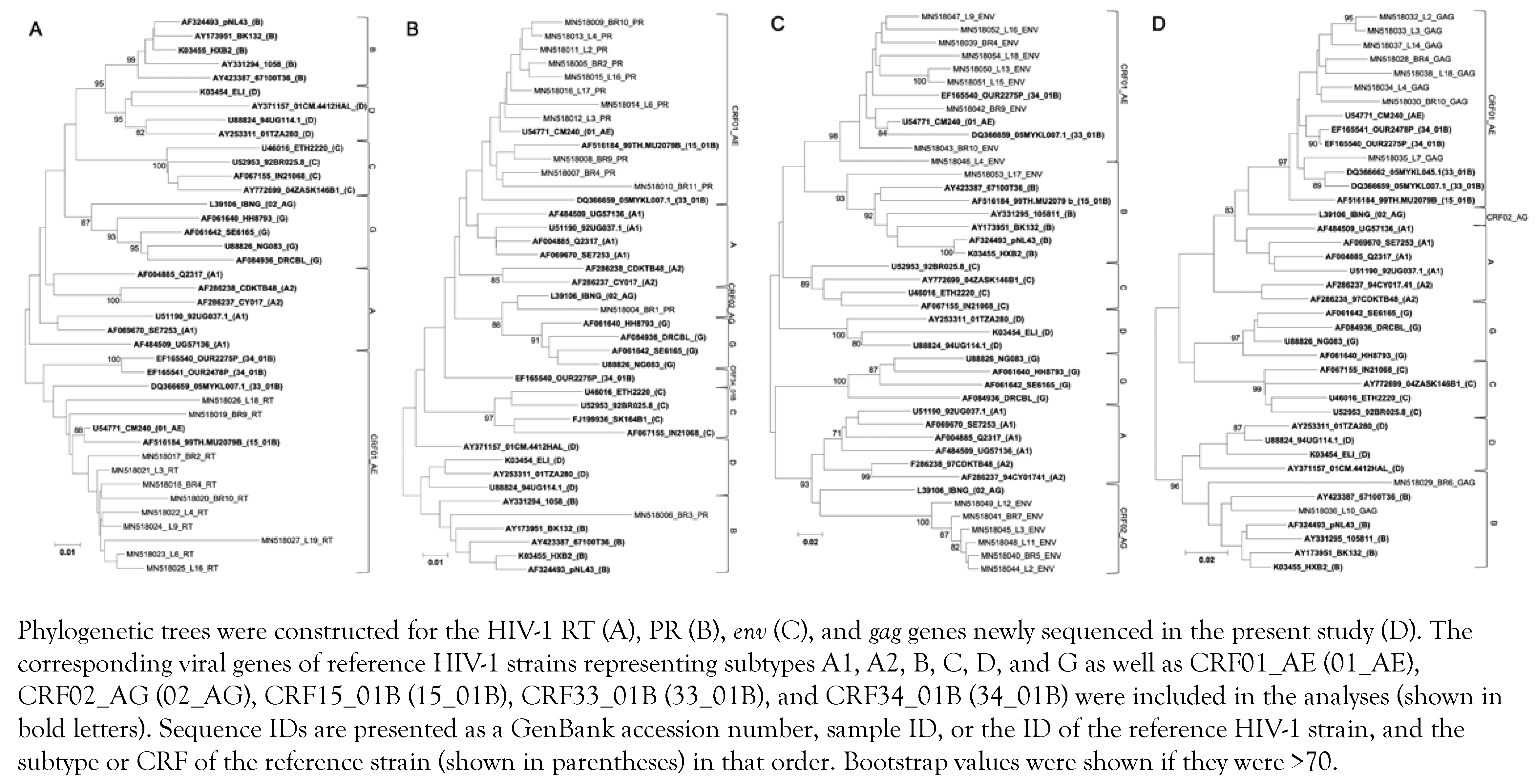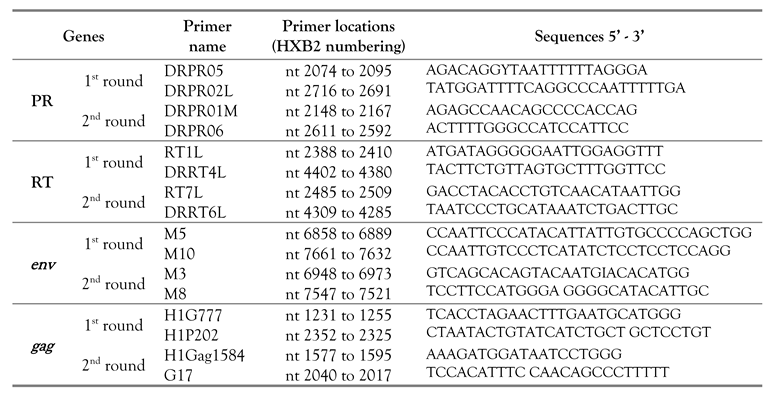Identification of HIV-1 Subtypes and Drug Resistance Mutations Among HIV-1-Infected Individuals Residing in Pontianak, Indonesia
Abstract
Introduction
Methods
Research participants and sample collection
Amplification of HIV-1 genomic fragments and sequencing analysis
HIV-1 subtyping and phylogenetic analysis
HIV drug resistance analysis
Ethics declaration
Results
Demographic and clinical data of study participants
HIV-1 subtyping
Prevalence of acquired drug resistance (ADR) and transmitted drug resistance (TDR)
Discussion
Conclusions
Author Contributions
Funding
Acknowledgments
Conflicts of Interest
References
- Joint United Nations Programme on HIV/AIDS (UNAIDS). Indonesia. 2019. Accessed on: 06 Match 2020. Available at: http://www.unaids.org/en/regionscountries/countries/i ndonesia/.
- Ministry of Health Republic Indonesia. HIV epidemiology review, Indonesia 2016. Directorate General of Disease Prevention and Control. 2017. 1-66p. Accessed on: 06 Match 2020. Available at: https://id.scribd.com/document/409741880/HIV- EPIDEMIOLOGY-REVIEW-INDONESIA-2016-pdf.
- Government of Pontianak. Investment profile in Pontianak, 2018. 2018. Accessed on: 06 Match 2020. Available at: http://dpmtk.pontianakkota.go.id/layanan/docs/2019/ BukuProfil2018.
- Kotaki, T.; Khairunisa, S.Q.; Witaningrum, A.M.; et al. HIV-1 transmitted drug resistance mutations among antiretroviral therapy-naïve individuals in Surabaya, Indonesia. AIDS Res Ther. 2015, 12, 5. [Google Scholar] [CrossRef] [PubMed]
- Khairunisa, S.Q.; Ueda, S.; Witaningrum, A.M.; et al. Genotypic characterization of human immunodeficiency virus type 1 prevalent in Kepulauan Riau, Indonesia. AIDS Res Hum Retroviruses 2018, 34, 555–560. [Google Scholar] [CrossRef] [PubMed]
- Indriati, D.W.; Kotaki, T.; Khairunisa, S.Q.; et al. Appearance of drug resistance mutations among the dominant HIV-1 subtype, CRF01_AE in Maumere, Indonesia. Curr HIV Res. 2018, 16, 158–166. [Google Scholar] [CrossRef] [PubMed]
- Yunifiar, M.Q.; Kotaki, T.; Witaningrum, A.M.; et al. Sero-and molecular epidemiology of HIV-1 in Papua Province, Indonesia. Acta Med Indones. 2017, 49, 205–214. [Google Scholar] [PubMed]
- Witaningrum, A.M.; Kotaki, T.; Khairunisa, S.Q.; et al. Genotypic characterization of human immunodeficiency virus type 1 derived from antiretroviral therapy-naive individuals residing in Sorong, West Papua. AIDS Res Hum Retroviruses. 2016, 32, 812–817. [Google Scholar] [CrossRef] [PubMed]
- Megasari, N.L.A.; Oktafiani, D.; Fitriana, E.; et al. The emergence of HIV-1 transmitted drug resistance mutations among antiretroviral therapy-naive individuals in Buleleng, Bali, Indonesia. Acta Med Indones. 2019, 51, 197–204. [Google Scholar]
- Wensing, A.M.; Calvez, V.; Günthard, H.F.; et al. 2017 update of the drug resistance mutations in HIV-1. Top Antivir Med. 2016, 24, 132–133. [Google Scholar]
- Li, X.; Liu, H.; Liu, L.; et al. Tracing the epidemic history of HIV-1 CRF01_AE clusters using near-complete genome sequences. Sci Rep. 2017, 7, 4024. [Google Scholar] [CrossRef]
- Salvaña, E.M.T.; Schwem, B.E.; Ching, P.R.; Frost, S.D.W.; Ganchua, S.K.C.; Itable, J.R. The changing molecular epidemiology of HIV in the Philippines. Int J Infect Dis. 2017, 61, 44–50. [Google Scholar] [CrossRef] [PubMed]
- Dey, S.K.; Zahan, N.; Afrose, S.; et al. Molecular epidemiology of HIV in Asia. HIV AIDS Rev. 2014, 13, 33–39. [Google Scholar] [CrossRef]
- Hemelaar, J.; Elangovan, R.; Yun, J.; et al. Global and regional molecular epidemiology of HIV-1, 1990-2015: a systematic review, global survey, and trend analysis. Lancet Infect Dis. 2019, 19, 143–155. [Google Scholar] [CrossRef] [PubMed]
- Chu, M.; Zhang, W.; Zhang, X.; et al. HIV-1 CRF01_AE strain is associated with faster HIV/AIDS progression in Jiangsu Province, China. Sci Rep. 2017, 7, 1570. [Google Scholar] [CrossRef] [PubMed]
- Li, X.; Xue, Y.; Cheng, H.; et al. HIV-1 genetic diversity and its impact on baseline CD4+T cells and viral loads among recently infected men who have sex with men in Shanghai, China. PLoS One 2015, 10, e0129559. [Google Scholar] [CrossRef] [PubMed]
- Iemwimangsa, N.; Pasomsub, E.; Sukasem, C.; Chantratita, W. Surveillance of HIV-1 drug-resistance mutations in Thailand from 1999 to 2014. Southeast Asian J Trop Med Public Health 2017, 48, 271–281. [Google Scholar] [PubMed]
- Ministry of Health Republic of Indonesia (Kementerian Kesehatan Republik Indonesia). Peraturan Menteri Kesehatan Republik Indonesia Nomor 87 Tahun 2014 tentang Pedoman Pengobatan Antiretroviral No Title. 2014. Accessed on: 06 March 2020. Available at: http://preventcrypto.org/wp- content/uploads/2015/10/IndonesiaAdultARTguidelin es20141432907982.pdf.
- Trinh, Q.M.; Nguyen, H.L.; Nguyen, V.N.; Nguyen, T.V.; Sintchenko, V.; Marais, B.J. Tuberculosis and HIV co-infection-focus on the Asia-Pacific region. Int J Infect Dis. 2015, 32, 170–178. [Google Scholar] [CrossRef] [PubMed]
- Machnowska, P.; Meixenberger, K.; Schmidt, D.; et al. Prevalence and persistence of transmitted drug resistance mutations in the German HIV-1 Seroconverter Study Cohort. PLoS One. 2019, 14, e0209605. [Google Scholar] [CrossRef] [PubMed]
- Levintow, S.N.; Okeke, N.L.; Hué, S.; et al. Prevalence and transmission dynamics of HIV-1 transmitted drug resistance in a southeastern cohort. Open Forum Infect Dis. 2018, 5, ofy178. [Google Scholar] [CrossRef] [PubMed]
- Aldous, A.M.; Castel, A.D.; Parenti, D.M.; DC Cohort Executive Committee. Prevalence and trends in transmitted and acquired antiretroviral drug resistance, Washington, DC, 1999-2014. BMC Res Notes 2017, 10, 474. [Google Scholar] [CrossRef] [PubMed]
- Zhao, S.; Feng, Y.; Hu, J.; et al. Prevalence of transmitted HIV drug resistance in antiretroviral treatment naïve newly diagnosed individuals in China. Sci Rep. 2018, 8, 12273. [Google Scholar] [CrossRef] [PubMed]
- Tchouwa, G.F.; Eymard-Duvernay, S.; Cournil, A.; et al. Nationwide estimates of viral load suppression and acquired HIV drug resistance in Cameroon. EClinicalMedicine. 2018, 1, 21–27. [Google Scholar] [CrossRef] [PubMed]
- Ministry of Health of Indonesia (Kementerian Kesehatan Republik Indonesia). Laporan Situasi Perkembangan HIV-AIDS & PIMS di Indonesia Januari-Desember 2017. 2018. Accessed on: 06 March 2020. Available at: https://id.scribd.com/document/391560045/Laporan- HIV-AIDS-TW-4-Tahun-2017-1-pdf.


| Characteristics | Total | On ART | Non-ART |
| Sample number | 30 | 19 | 11 |
| Age, mean years (SD) | 33.8 (6.2) | 33.9 | 33.5 |
| Sex, n (%) | |||
| Male | 24 (80.0%) | 18 (94.7%) | 6 (54.5%) |
| Female | 6 (20.0%) | 1 (5.3%) | 5 (45.5%) |
| Marital status, n (%) Married | 30 (100.0%) | 19 (100.0%) | 11 (100.0%) |
| Single | 0 (0.0%) | 0 (0.0%) | 0 (0.0%) |
| Transmission risk category, n (%) | |||
| Heterosexual intercourse | 7 (23.3%) | 2 (10.5%) | 5 (45.5%) |
| Intravenous drug use | 20 (66.7%) | 17 (89.5%) | 3 (27.3%) |
| Homosexual intercourse | 3 (10.0%) | 0 (0.0%) | 3 (27.3%) |
| Types of ART used, n (%) | |||
| 3TC+AZT+NVP | 11 (36.7%) | 11 (57.9%) | 0 (0.0%) |
| 3TC+AZT+EFV | 2 (6.7%) | 2 (10.5%) | 0 (0.0%) |
| Others | 6 (20.0%) | 6 (31.6%) | 0 (0.0%) |
| Duration of ART, n (%) <1 year | 0 (0%) | 0 (0.0%) | 0 (0.0%) |
| 1-3 years | 2 (6.7%) | 2 (10.5%) | 0 (0.0%) |
| >3 years | 17 (56.7%) | 17 (89.5%) | 0 (0.0%) |
| Opportunistic infection, n (%) No | 2 (6.7%) | 2 (10.5%) | 0 (0.0%) |
| Yes | 28 (93.3%) | 17 (89.5%) | 11 (100.0%) |
| Sample ID | Treatment | Subtype/CRF assignment | PR gene | Subt RT gene | yping Env gene | Gag gene |
| BR1 | Non-ART | CRF02_AG* | CRF02_AG | NA** | NA | NA |
| BR2 | Non-ART | CRF01_AE | CRF01_AE | CRF01_AE | NA | NA |
| BR3 | Non-ART | B | B | NA | NA | NA |
| BR4 | Non-ART | CRF01_AE | CRF01_AE | CRF01_AE | CRF01_AE | CRF01_AE |
| BR5 | Non-ART | CRF02_AG | NA | NA | CRF02_AG | NA |
| BR6 | Non-ART | B | NA | NA | NA | B |
| BR8 | Non-ART | NA | NA | NA | NA | |
| BR7 | Non-ART | CRF02_AG | NA | NA | CRF02_AG | NA |
| BR9 | Non-ART | CRF01_AE | CRF01_AE | CRF01_AE | CRF01_AE | NA |
| BR10 | Non-ART | CRF01_AE | CRF01_AE | CRF01_AE | CRF01_AE | CRF01_AE |
| BR11 | Non-ART | CRF01_AE | CRF01_AE | NA | NA | NA |
| L1 | On ART | NA | NA | NA | NA | NA |
| L2 | On ART | CRF01_AE | CRF01_AE | NA | CRF02_AG | CRF01_AE |
| L3 | On ART | CRF01_AE | CRF01_AE | CRF01_AE | CRF02_AG | CRF01_AE |
| L4 | On ART | CRF01_AE | CRF01_AE | CRF01_AE | CRF01_AE | CRF01_AE |
| L5 | On ART | NA | NA | NA | NA | NA |
| L6 | On ART | CRF01_AE | CRF01_AE | CRF01_AE | NA | NA |
| L7 | On ART | CRF01_AE | NA | NA | NA | CRF01_AE |
| L8 | On ART | NA | NA | NA | NA | NA |
| L9 | On ART | CRF01_AE | NA | CRF01_AE | CRF01_AE | NA |
| L10 | On ART | B | NA | NA | NA | B |
| L11 | On ART | CRF02_AG | NA | NA | CRF02_AG | NA |
| L12 | On ART | CRF02_AG | NA | NA | CRF02_AG | NA |
| L13 | On ART | CRF01_AE | NA | NA | CRF01_AE | NA |
| L14 | On ART | CRF01_AE | NA | NA | NA | CRF01_AE |
| L15 | On ART | CRF01_AE | NA | NA | CRF01_AE | NA |
| L16 | On ART | CRF01_AE | CRF01_AE | CRF01_AE | CRF01_AE | NA |
| L17 | On ART | CRF01_AE/B*** | CRF01_AE | NA | B | NA |
| L18 | On ART | CRF01_AE | NA | CRF01_AE | CRF01_AE | CRF01_AE |
| L19 | On ART | CRF01_AE | NA | CRF01_AE | NA | NA |
| Sample ID | ART Regimen | Drug Resistance Mutations * | ||
| NRTI | NNRTI | Confer resistance to | ||
| L18 | AZT+3TC+NVP | K65R | - | ABC, ddI, FTC, 3TC, |
| TDF+3TC+NVP | M184V | Y181C | d4T, TDF, AZT, EFV, | |
| K219E | G190A | ETR, NVP, RPV | ||
| L19 | 3TC+AZT+NVP | - | K130T | EFV |
| P225H | ||||
© GERMS 2020.
Share and Cite
Khairunisa, S.Q.; Megasari, N.L.A.; Indriati, D.W.; Kotaki, T.; Natalia, D.; Nasronudin; Kameoka, M. Identification of HIV-1 Subtypes and Drug Resistance Mutations Among HIV-1-Infected Individuals Residing in Pontianak, Indonesia. GERMS 2020, 10, 174-183. https://doi.org/10.18683/germs.2020.1203
Khairunisa SQ, Megasari NLA, Indriati DW, Kotaki T, Natalia D, Nasronudin, Kameoka M. Identification of HIV-1 Subtypes and Drug Resistance Mutations Among HIV-1-Infected Individuals Residing in Pontianak, Indonesia. GERMS. 2020; 10(3):174-183. https://doi.org/10.18683/germs.2020.1203
Chicago/Turabian StyleKhairunisa, Siti Qamariyah, Ni Luh Ayu Megasari, Dwi Wahyu Indriati, Tomohiro Kotaki, Diana Natalia, Nasronudin, and Masanori Kameoka. 2020. "Identification of HIV-1 Subtypes and Drug Resistance Mutations Among HIV-1-Infected Individuals Residing in Pontianak, Indonesia" GERMS 10, no. 3: 174-183. https://doi.org/10.18683/germs.2020.1203
APA StyleKhairunisa, S. Q., Megasari, N. L. A., Indriati, D. W., Kotaki, T., Natalia, D., Nasronudin, & Kameoka, M. (2020). Identification of HIV-1 Subtypes and Drug Resistance Mutations Among HIV-1-Infected Individuals Residing in Pontianak, Indonesia. GERMS, 10(3), 174-183. https://doi.org/10.18683/germs.2020.1203




